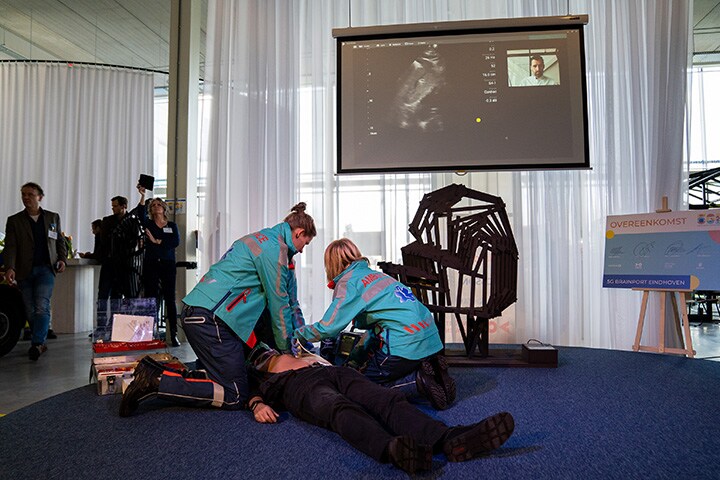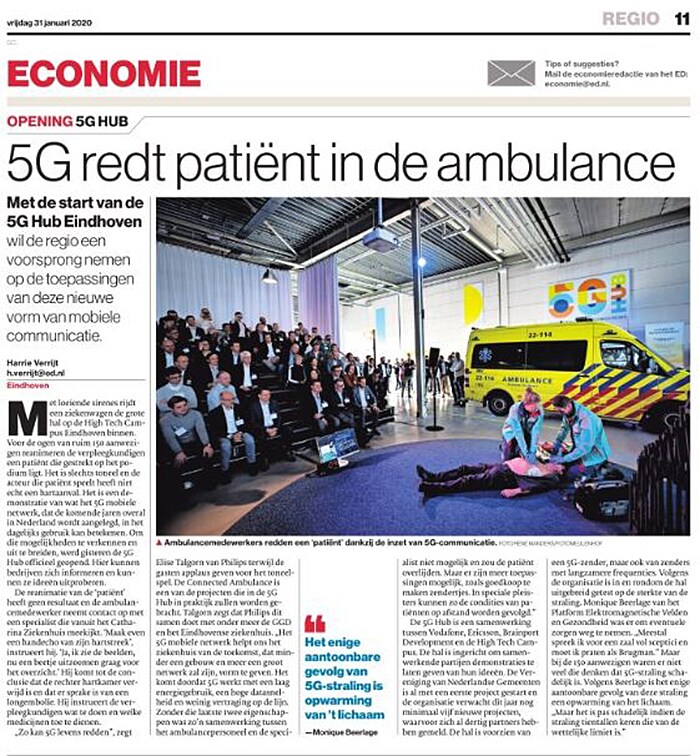For English see below
Het Eindhovens Dagblad was bij de opening van de 5G Hub op de High Tech Campus. Hiermee wil de regio een voorsprong nemen op de mogelijkheden van deze nieuwe techniek. Zo’n 150 aanwezigen zagen een demonstratie van het potentieel van het 5G mobiele netwerk in het dagelijks gebruik.
Connected Ambulance
Met loeiende sirenes rijdt een ziekenwagen de grote hal binnen. De verpleegkundigen proberen hun patiënt (acteur) te redden door hem te reanimeren, maar dat lukt niet. Zij nemen daarom via het 5G-netwerk live contact op met een trauma-arts die vanuit het Catharina Ziekenhuis meekijkt. Hij beoordeelt de echo die de ambulancemedewerker ter plekke maakt, stelt een diagnose en geeft de verpleegkundigen instructies wat te doen. Deze ‘patiënt’ is gered.
Het 5G mobiele netwerk helpt ons het ziekenhuis van de toekomst, dat minder een gebouw en meer ene groot netwerk zal zijn, vorm te geven. Zo kan 5G levens redden.
Elise Talgorn
Senior Design Strategist bij Philips

Ziekenhuis van de toekomst
Elise Talgorn, Senior Design Strategist bij Philips, legt uit: “Het 5G mobiele netwerk helpt ons het ziekenhuis van de toekomst, dat minder een gebouw en meer een groot netwerk zal zijn, vorm te geven. Zo kan 5G levens redden.” Er is een groeiend tekort aan personeel in de zorg en een toenemende behoefte aan zorg omdat mensen langer leven. Om ook in de toekomst kwalitatieve zorg te kunnen blijven verlenen, moet zorg op een andere manier georganiseerd worden. Hierbij is een belangrijke rol weggelegd voor digitalisering. 5G kan op diverse manieren zorg op afstand ondersteunen.
Innoveren met 5G
Philips onderzoekt met onder meer GGD Brabant-Zuidoost en het Catharina Ziekenhuis hoe de ‘Connected Ambulance’ in de praktijk kan worden gebracht. 5G werkt met een laag energiegebruik, hoge datasnelheid en weinig vertraging op de lijn. Zonder die laatste twee eigenschappen is zo’n samenwerking tussen het ambulancepersoneel en de specialist niet mogelijk.
Kostbare tijd winnen als elke minuut telt
Echografie wordt nu zelden gebruikt in ambulances bij medische spoedgevallen, omdat het beoordelen van echo’s specialistische kennis en training vereist. Tijdens de demonstratie werd getoond hoe echografie die ondersteund wordt door 5G de mogelijkheid kan gaan bieden om ook ter plekke een echo uit te voeren. Hierbij wordt het voor een arts op afstand mogelijk om live mee te kijken, instructies te geven en de echografie real-time te beoordelen. Met hulp van een arts-op-afstand kan er eerder een diagnose gesteld worden bij de patiënt en sneller gestart worden met de behandeling, zoals het ter plaatse toedienen van medicatie. Hiermee kan kostbare tijd gewonnen worden op een moment waarop elke minuut telt.

Eindhovens Dagblad: 5G saves patient in ambulance
Eindhovens Dagblad’ was present at the opening of the 5G Hub on the High Tech Campus. With this hub, the region wants to take a head start exploring the possibilities of this new technique. Around 150 attendees viewed a demonstration of the potential of the 5G mobile network in daily use.
Connected Ambulance
An ambulance drives into the main hall with loud sirens. The nurses try to save their patient (an actor) by resuscitating him, but they don't succeed. They then use the 5G network to make live contact with a trauma doctor who is watching from the Catharina Hospital. He evaluates the ultrasound scan made on site by the ambulance operator, makes a diagnosis and instructs the nurses what to do. This 'patient' is saved.
The 5G mobile network helps us shape the hospital of the future, which will be less of a building and more of a large network. In this way, 5G can save lives.
Elise Talgorn
Senior Design Strategist at Philips

Hospital of the future
Elise Talgorn, Senior Design Strategist at Philips, explains: "The 5G mobile network will help us shape the hospital of the future, which will be less of a building and more of a large network. In this way, 5G can save lives." There is a growing shortage of care personnel and an increasing need for care because people are living longer. In order to be able to continue to provide high-quality care in the future, care must be organized in a different way. Digitization has an important role to play here. 5G can support remote care in various ways.
Innovating with 5G
Philips, together with among other GGD Brabant-Zuidoost and Catharina Ziekenhuis, is investigating how the 'Connected Ambulance' can be put into practice. 5G works with low energy consumption, high data speed and little delay on the line. Without the latter two features, such cooperation between the ambulance staff and the specialist at the hospital is not feasible.
Gaining precious time when every minute counts
Because ultrasound assessment requires specialist knowledge and training, ultrasound is now rarely used in ambulances during medical emergencies. During the demonstration it was shown how ultrasound supported by 5G can be used to perform an ultrasound on site. This will allow a remote doctor to watch live, give instructions and assess the ultrasound in real time. With the help of a remote doctor, a patient can be diagnosed earlier and treatment such as the administration of medication on site can start sooner. This can save valuable time at a time when every minute counts.
Deel op social media
Onderwerpen
Contact

Tommie Dijstelbloem
Woordvoerder Philips Benelux Tel: +31 6 19 28 83 20
You are about to visit a Philips global content page
Continue
